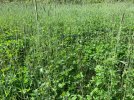bornagain62511
5 year old buck +
spring planting rye works great to suppress weeds. I've used it in my garden a lot in areas that I don't plant with garden crops in early spring. I plant several crops of vegetables throughout the summer and till the rye in just before planting the next crop of vegetables. the rye will get about a foot tall and very thick, but starts to go dormant in June/July. Mowing it helps keep it growing somewhat, but once summer heat comes, spring planted rye really slows down a lot. I planted it in April and May with Swedes (rutabagas) last April and May in our food plots, but the swedes grow so slow and the rye stunted the swedes so much and then the weeds took over after the rye went dormant in mid summer. I also planted rye in May in other years along with Winfred forage brassica and the Winfred grows so much faster than the swedes and did quite well. once the rye and Winfred got about 10" tall, the Winfred took off upward in growth as the rye started to slow down and eventually got drowned out under the canopy of the Winfred. you can see how tall and thick the Winfred gets in previous post on this thread.
you could plant rye as soon as the frost is out of the ground in the spring.
last year I learned I will never plant swedes again. way too slow growing. they need nearly perfect weed control and lots of fertilizer to grow and produce well. Purple top turnips and Winfred grow so much faster and compete well with weeds. we don't use chemicals on our food plots so faster growing plants like these that will have the advantage over weeds are a must. This year, I'm planning to plant most of our plots in a mix of 4 lbs. of PPT and 1 lb of Winfred per acre in Mid June without any rye. Rye seems to suck up a lot of nutrients that the brassicas could use. And with mostly PPT in the mix this time, I think those will work good at suppressing weeds and once the Winfred reaches about 12" tall it will really shoot up and get the height we need with our deep snows in winter. So hopefull it's a nice mix of large bulbs from the PPT and the tall large leafs of the Winfred, that should be the ultimate fall/winter plot around here. I've been doing food plots for over 20 years here in southwest Wisconsin and radishes/rye/oats might have a slight more attractiveness in early/mid fall, but not by much. our deer even feed on the Winfred quite a bit all summer long. And the deer love the Winfred and PPT in early to mid fall as it is, so I don't bother with rye/radish anymore. And when they need it most in late fall and through the winter, there's nothing that I know of that is better than Winfred and PPT for feeding and attracting deer around here.
you could plant rye as soon as the frost is out of the ground in the spring.
last year I learned I will never plant swedes again. way too slow growing. they need nearly perfect weed control and lots of fertilizer to grow and produce well. Purple top turnips and Winfred grow so much faster and compete well with weeds. we don't use chemicals on our food plots so faster growing plants like these that will have the advantage over weeds are a must. This year, I'm planning to plant most of our plots in a mix of 4 lbs. of PPT and 1 lb of Winfred per acre in Mid June without any rye. Rye seems to suck up a lot of nutrients that the brassicas could use. And with mostly PPT in the mix this time, I think those will work good at suppressing weeds and once the Winfred reaches about 12" tall it will really shoot up and get the height we need with our deep snows in winter. So hopefull it's a nice mix of large bulbs from the PPT and the tall large leafs of the Winfred, that should be the ultimate fall/winter plot around here. I've been doing food plots for over 20 years here in southwest Wisconsin and radishes/rye/oats might have a slight more attractiveness in early/mid fall, but not by much. our deer even feed on the Winfred quite a bit all summer long. And the deer love the Winfred and PPT in early to mid fall as it is, so I don't bother with rye/radish anymore. And when they need it most in late fall and through the winter, there's nothing that I know of that is better than Winfred and PPT for feeding and attracting deer around here.









